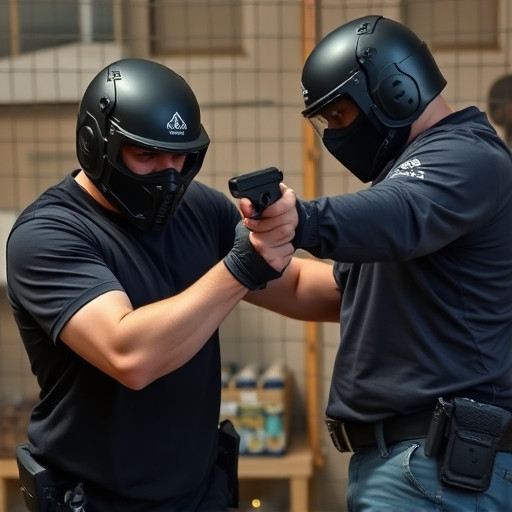Unveiling Stun Gun Science: Spread Patterns & Non-Lethal Technology Online
The optimal design and safe operation of non-lethal stun guns available online hinge on understandin…….
The optimal design and safe operation of non-lethal stun guns available online hinge on understanding electrical current propagation. By analyzing factors like current density, flow direction, and intensity distribution at contact points, researchers can enhance device efficiency while minimizing collateral damage. Online resources provide a wealth of information about stun gun technology, allowing users to compare models based on key specifications such as voltage, amperage, and pulse width. This knowledge base, bolstered by expert reviews and scientific research, is crucial for ensuring the effectiveness and safety of non-lethal stun guns used in law enforcement, security, and civilian self-defense.
Electrical current spread patterns play a pivotal role in understanding non-lethal stun gun technology. This article delves into the intricacies of both concepts, providing a comprehensive guide for readers interested in the science behind non-lethal force tools. We explore how electrical currents behave and analyze their spread patterns, offering a critical perspective on their effectiveness. Additionally, we direct you to valuable online resources for further exploration of stun gun technology, ensuring an informed understanding of these devices.
- Understanding Electrical Current and Its Behavior
- The Science Behind Non-Lethal Stun Guns
- Analyzing Spread Patterns: A Critical Perspective
- Online Resources for Deepening Your Knowledge on Stun Gun Technology
Understanding Electrical Current and Its Behavior

Electrical current, a flow of charged particles, forms the basis of numerous technologies we rely on daily. When it comes to analyzing its spread patterns, especially in the context of non-lethal stun guns available online, understanding how current behaves is paramount. Unlike conventional weapons that use projectiles, stun guns deploy electrical energy to incapacitate a target temporarily, making current flow analysis crucial for ensuring effectiveness and safety.
The pattern of electrical current’s propagation reveals important insights into the device’s performance. By studying how the current disperses through different materials and across the body of a subject, researchers can optimize stun gun design. This includes identifying optimal contact points for maximum shock delivery while minimizing collateral damage, which is essential in scenarios where non-lethal force is required, such as law enforcement operations.
The Science Behind Non-Lethal Stun Guns

Non-lethal stun guns, also known as electronic control devices (ECDs), utilize electrical current to incapacitate a target temporarily without causing permanent harm. The technology behind these weapons involves advanced electronics and strategic energy delivery. When activated, the stun gun emits a high-voltage, low-current electric pulse that disrupts the nervous system’s communication with muscles, leading to muscle spasms and temporary paralysis. This disruption is achieved through specialized probes or electrodes designed to make physical contact with the target.
The spread pattern of electrical current in non-lethal stun guns is a critical aspect of their functionality. By carefully controlling the intensity, frequency, and duration of the electric pulse, manufacturers can ensure the energy is delivered effectively while minimizing off-target effects. Advanced models incorporate safety features like trigger controls, retention modes, and adjustable output levels to cater to various situations, making them popular choices for law enforcement, security personnel, and individuals seeking self-defense options, as evidenced by the growing market for non-lethal stun guns online.
Analyzing Spread Patterns: A Critical Perspective

Analyzing the spread pattern of electrical current is a critical aspect, especially in the context of non-lethal stun guns available online. These devices utilize electric shock as a less-than-lethal force to immobilize individuals, and understanding how the current flows can significantly impact their effectiveness and safety. By studying the patterns, researchers and manufacturers can optimize the design, ensuring the current reaches its target efficiently while minimizing collateral damage or injury to bystanders.
Such analysis involves examining factors like current density, flow direction, and intensity distribution across the contact points. This data is crucial for evaluating the device’s performance, identifying potential risks, and improving overall safety standards. Moreover, it aids in developing strategies to mitigate unintended consequences, particularly when considering the diverse applications of non-lethal stun guns, from law enforcement to civilian self-defense, available widely through online platforms.
Online Resources for Deepening Your Knowledge on Stun Gun Technology

For a comprehensive understanding of stun gun technology, exploring online resources dedicated to non-lethal self-defense tools is an excellent step. The internet offers a wealth of information, tutorials, and insights into how electrical current spreads through different mediums, which is crucial in gauging the effectiveness of stun guns. Websites and forums focused on personal safety often provide detailed analyses of various stun gun models, their design, and the science behind their operation.
These online platforms allow users to compare different non-lethal stun guns based on specifications like voltage, amperage, and pulse width—key factors in determining the device’s impact. Many expert reviews and user experiences can be found, offering practical insights into the real-world performance of these tools. Additionally, scientific articles and research papers are readily available, delving into the electrical current spread patterns and the physiological effects of stun guns, providing a deeper knowledge base for enthusiasts and professionals alike.
Electrical current spread pattern analysis is a crucial aspect of understanding the effectiveness and safety of non-lethal stun guns. By delving into the science behind these devices, we’ve explored how current behavior varies and how it can be measured. Analyzing spread patterns offers critical insights for improving technology and ensuring user safety. For those eager to deepen their knowledge on stun gun technology, exploring reputable online resources is a vital step. Remember that staying informed about non-lethal stun guns can contribute to making communities safer.


